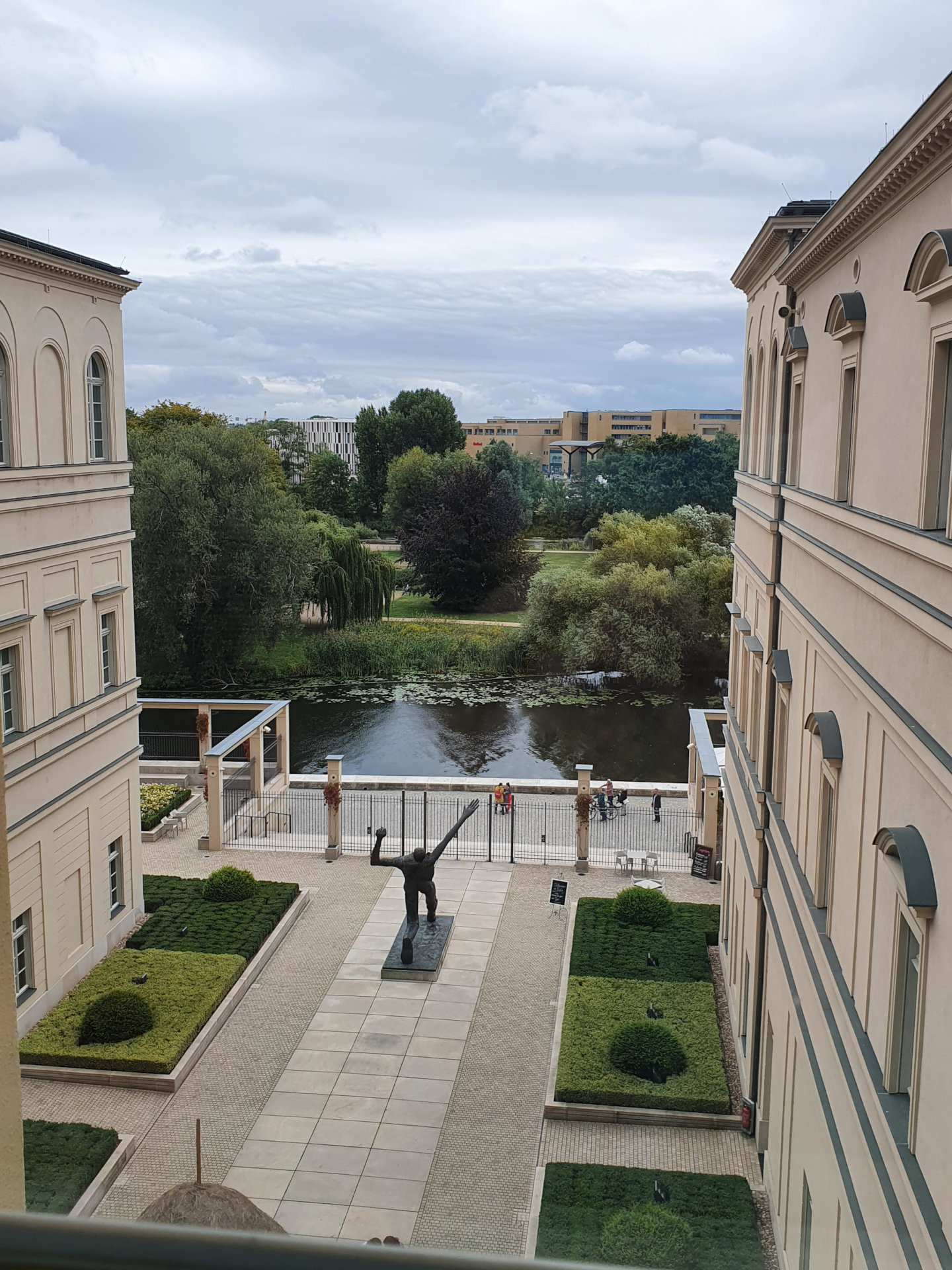Museum Barberini
One of the most striking private museums in Germany has to be the Museum Barberini. Contrary to the name, it owes its existence not to a Barberini but to Germany’s version of Bill Gates, a man named Hasso Plattner, a founder of SAP software. Plattner had the building constructed after a palazzo that stood on the site until WWII, but reinvented the interior to be more functional as a museum. The museum’s exhibitions are based on Plattner’s own wide-ranging art collection, from GDR artists to Warhol and – you guessed it! – Impressionists.
The first gallery (below) displays the history of the building, from the original Palazzo Barberini to the current museum. The interior courtyard (right) houses a sculpture by famous GDR artist Wolfgang Mattheuer, as well as a scenic cafe (around the corner to the right).
Impressionist Exhibition
As for the current exhibition of Impressionists, the artworks are breathtaking. Both well-known and more obscure paintings are included. And what a pleasure to be allowed to photograph them! This is one benefit of a private collection: the owner can decide to allow photography. The picture above shows two works juxtaposed in a room of paintings of harbors. (I wondered whether the matching off-white canvas inserts inside the frames, clearly added in one concerted action, were fillers to compensate for frames that were too large – ?) This generally thematic organization of the galleries, as well as the erudite historical texts in the labels, is a very standard way to display art. Yet even if the display didn’t set my curatorial heart beating faster, we can surely agree that we go to such a show to see the masterpieces, not the way they are displayed.
Private Museums
This is a great chance for the public to see art which, in the hands of other collectors, might easily have been locked into a freeport storage unit, never to see the light of day, fulfilling its purpose as an investment simply by existing. By contrast, showing art to the public is a benefit to the public and – depending on the applicable tax laws – to the donor. Ideally, it’s a win-win situation.
So should we hope for a Bill Gates Museum of Pop Art and a Warren Buffett Museum of Surrealist Painting? Or more extreme: should we stop paying taxes to sometimes lamentably inefficient state-run museums and entrust private donors to pick up the slack?
Private museums are wonderful enrichments to the cultural landscape, but one aspect of them requires careful reflection. A private donor is a single individual with personal preferences that influence their actions in creating a museum more than is possible in a team-based organization without a private patron. In the museum world, important private donors can influence the entire cultural landscape based on their own preferences. If Hasso Plattner had collected not Monets but plastic shopping bags from divided Germany, and displayed these in the museums, this genre of visual culture would have become much more well-known and high-value. The art market would change, and future art history textbooks might even include plastic bags. This sort of one-person influence is also present in the figure of the museum curator making decisions about accessioning and deaccessioning certain artworks in their collection; the phenomenon is simply magnified in the one-patron institution.
Similarly, certain values are expressed in the architecture of the Museum Barberini – ike any privately-built building – that reflect the donor’s wishes (in agreement with the local civic bodies, of course). If a different donor had come into Potsdam championing Zaha Hadid architecture, you can bet that the museum would look different! And it would make a different statement in the cityscape: a gesture toward Middle Eastern culture, modernism, and feminism, for instance. So here too, the power of a single donor defines not only the end result, but its message to the surrounding community.
Hopefully, in any given cultural area, there are enough state-run and generally diverse, team-based institutions to balance out such potential imbalances. Private museums have a lot to offer their communities. A perfect museum world has space for both public and private institutions, creating a plurality of perspectives.
What private museums have caught your attention lately? Let me know here in the comments, or via the Contact page – I’d love to hear from you!




Perhaps I should check out that museum again :-). But related to your piece, many (state) museums started out as private collections. It’s always good to remind ourselves and to be reminded how museums came into being, what they decide to display (and what not), and how they tell their stories. I think its great that your posts engage with these kinds of questions.
You are so right! Private collections were/are the foundation for so much – with all the pluses and minuses that that brings.